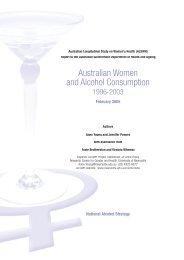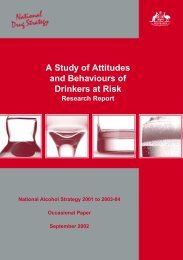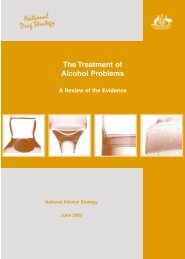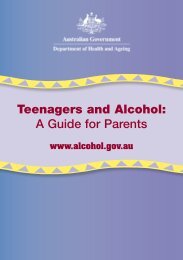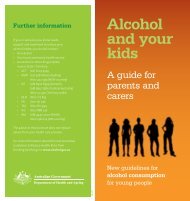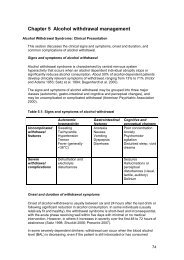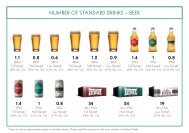Chapter 3 Screening, assessment and treatment planning - Alcohol
Chapter 3 Screening, assessment and treatment planning - Alcohol
Chapter 3 Screening, assessment and treatment planning - Alcohol
Create successful ePaper yourself
Turn your PDF publications into a flip-book with our unique Google optimized e-Paper software.
hazardous drinking (Skipsey et al. 1997). The AUDIT has also been evaluated inpsychiatric patients <strong>and</strong> in one study demonstrated very high sensitivity <strong>and</strong>specificity at detecting alcohol abuse using a cut- off of 10 (Cassidy et al. 2008). TheAUDIT-C also performed well against the S-MAST <strong>and</strong> CAGE in detecting riskdrinking among people with any past-year mood disorder (Dawson et al. 2005). Inanother study of patients affected by a mood disorder, AUDIT <strong>and</strong> CAGE werecompared with the first 2 questions of the NIAA guide (“do you sometimes drinkalcohol?” <strong>and</strong> “how many times in the past year have you had 5 drinks [men] 4[women] in a day?”). Both instruments achieved high sensitivity, using a cut-off of 5for AUDIT <strong>and</strong> 1 for CAGE (Agabio et al. 2007).Overall it appears that the AUDIT is superior to other instruments in detecting variousaspects of a range of alcohol problems. CAGE is proven to be insufficient to detectlower levels of alcohol abuse among primary care patients, <strong>and</strong> conventionallaboratory tests were proved in at least one study to be of no use in this setting(Aertgeerts et al. 2001).The AUDIT can be also used effectively to identify hazardous, problem <strong>and</strong>dependent alcohol consumption amongst psychiatric patients; AUDIT-C can be usedto detect alcohol use disorders, using a cut-off of 5 (Dawson et al. 2005).Other questionnairesThe <strong>Alcohol</strong>, Smoking <strong>and</strong> Substance Involvement <strong>Screening</strong> Test (ASSIST) is auseful screening questionnaire, recommended by the World Health Organization,which includes alcohol with other substances (World Health Organization 2002).A number of other screening instruments have been developed to overcome thelimitations of existing inventories. These are most useful for research rather thanclinical settings <strong>and</strong> are not considered further in these guidelines.Recommendation3.6 AUDIT is the most sensitive of the currentlyavailable screening tools <strong>and</strong> is recommendedfor use in the general population.Strength ofrecommendationALevel ofevidenceI<strong>Screening</strong> for alcohol use in special populations: Pregnant WomenThe NHMRC guidelines recommend that it is safest to consume no alcohol duringpregnancy (NHMRC 2009). The low levels of consumption highlighted as a concernin recent guidelines cannot be identified using current questionnaires. A clinicalhistory to estimate the quantity <strong>and</strong> frequency of alcohol use is the preferred method.In light of the potential for adverse effects on the foetus, screening for alcohol useshould be included in the usual antenatal history. All pregnant women should beasked about their level of alcohol consumption.TWEAK <strong>and</strong> T-ACE questionnaires22



